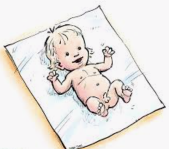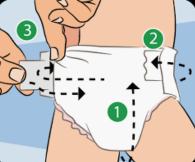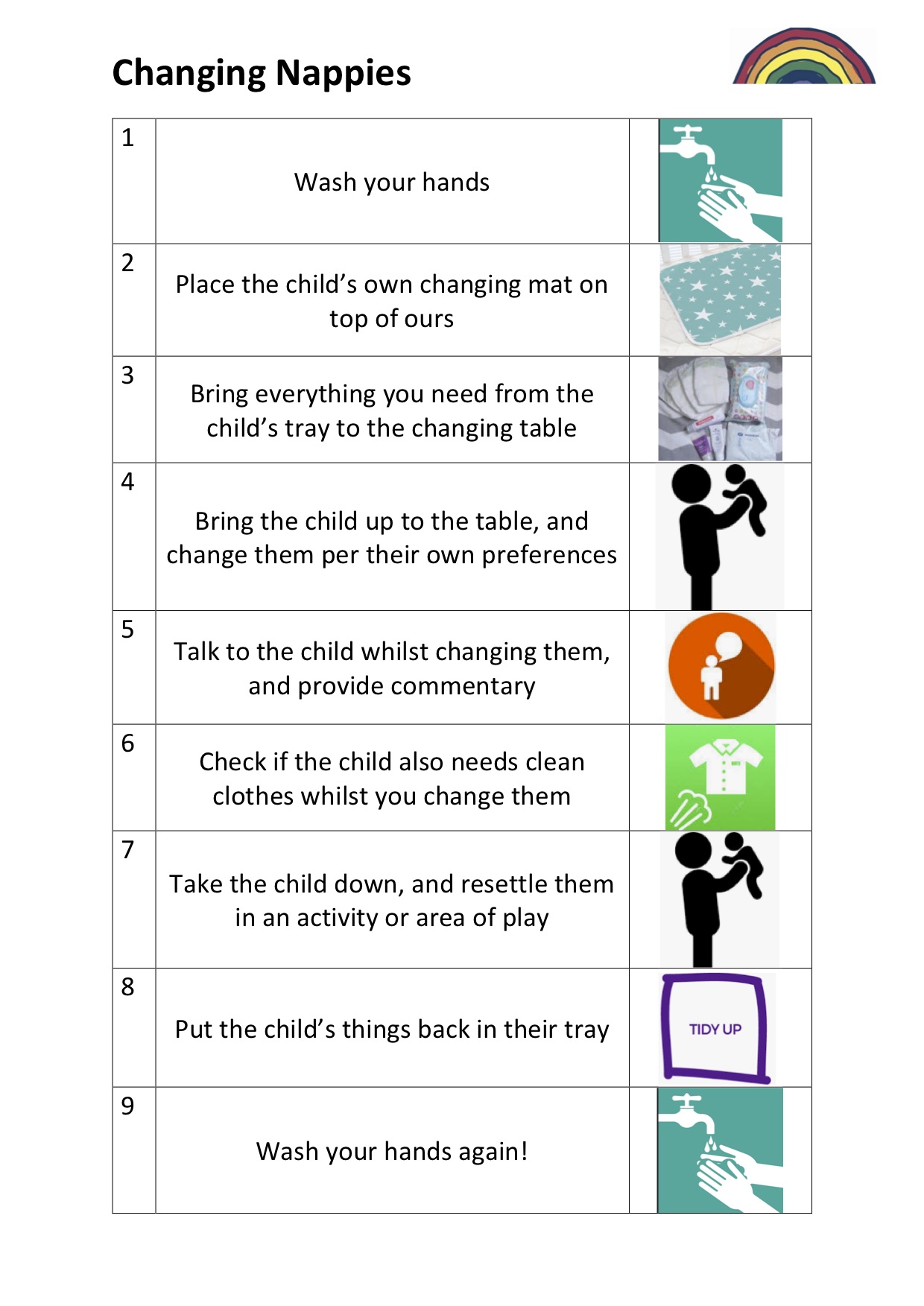 It’s important to develop positive nappy changing and toileting routines as they form a significant part of a child’s daily routine in care. As well as meeting a child’s physical needs when you help with them toileting or change a nappy your actions will also help you build a strong and trusting relationship with a child. The special 1:1 time you share with a child during nappy change time also significantly supports the child with language development, providing you talk and communicate in a meaningful way with each child, as you change them!
It’s important to develop positive nappy changing and toileting routines as they form a significant part of a child’s daily routine in care. As well as meeting a child’s physical needs when you help with them toileting or change a nappy your actions will also help you build a strong and trusting relationship with a child. The special 1:1 time you share with a child during nappy change time also significantly supports the child with language development, providing you talk and communicate in a meaningful way with each child, as you change them!
Infection control and hygiene:
Gastrointestinal illnesses including Norovirus, Salmonella, or E Coli O157 are highly infectious and can potentially be transmitted in the nappy changing area if good standard infection prevention and control precautions (SICPs) are not adhered to. Hygienic nappy changing practice and effective cleaning of equipment and the environment is vital to reduce the risks of transmitting infection to children and staff.
Infections are caused by microorganisms including bacteria, fungi and viruses. There are many types of microorganisms; they are found everywhere and most are harmless. However, certain microorganisms, often called germs, can harm those vulnerable to infection. Children and those who care for them may be exposed to these harmful microorganisms within childcare settings, more than children cared for in their own homes.
Hygienic nappy changing practice and effective decontamination of equipment and the environment is vital to reduce the risks of transmitting infection to children and staff. It is important that the nappy changing areas are cleaned regularly by the childcare staff. Clothes and wipes used to clean nappy changing areas, should not be used in any other areas of the nursery.
Some other key hygiene management guidelines:
- Children and staff must never share hand washing water in communal basins
- Hand sanitisers are not a substitute for handwashing
- It is good practice is to allow children including babies to wash their hands
- after nappy changing.
- Children must be changed only on their own mat
- Staff must wash their own hands before and after every child is changed
- Staff may wish to wear gloves, this is not mandatory; where gloves are worn, hands should still be washed before and after changing, and new gloves should be worn for each child change
The nappy change experience from the child’s perspective:
The nappy changing experience should be a relaxed, happy and social routine that  provides valuable opportunities for interactions between staff and children on an individual basis. The environment should be organised in a way that promotes those positive interactions while also supporting positive learning experiences.
provides valuable opportunities for interactions between staff and children on an individual basis. The environment should be organised in a way that promotes those positive interactions while also supporting positive learning experiences.
It is good practice is to allow children including babies to wash their hands after nappy changing. – this promotes good hygiene practice from an early age
Good experiences on the change table will:
- Give you the opportunity to interact with children and engage in simple play activities such as singing and rhyme games.
- Help you teach children about daily routine and cause and effect.
- Give you an early opportunity to teach children about self care, through showing them how to hand wash and dress themselves and by sharing with them the sense of achievement gained through learning these skills.
- It is also important to remember that the way that staff react to soiled or wet nappies, toileting needs and accidents give children powerful messages about themselves and their bodies.
Nappy changing
- Nappies should be changed only in the nappy change areas, or on each child’s matrass on their own sheets, as they wake up. The change table should be cleaned after each change.
- The change table should be cleaned thoroughly at midday and again at the end of the day – cleaning should include underneath the change mat
- The Nursery cover for the changing mat should be changed daily, and always covered with the child’s own mat when in use
- Nappies and change supplies such as wipes, creams are stored in the child’s personal nappy changing tray, and spare clothes on their peg.
- Plastic bags should be within arm’s reach of adults but inaccessible to children
- To minimise the chances of children falling off the change table carers must keep one hand on the child at all times during nappy changing. Child must NEVER be alone on the changing table. If staff need to step away for a second, to get something, you should call another staff member for assistance or take the child OFF the table
Supporting children during nappy changes
By consistently applying a range of practical strategies staff can work to ensure toileting and nappy change experiences are positive for children. These include:
- Slowing down and allowing children to take their time so they feel relaxed.
- Using correct vocabulary to describe words associated with nappy changing and toileting.
- Allowing children to be active participants in the process and encouraging them to help where it is age appropriate.
- Being sensitive to the different needs of children and where possible making small changes to the nappy change routine to take into account these needs.
- Changing nappies when they need to be changed rather than just at set times and encouraging children to communicate when they need a change.
- Talking with children while changing the nappy using correct vocabulary and respectful language; communicating with children during the process helps them understand what is going on and what will happen next.
- Focusing on making a nappy change time a positive experience for the child by taking into account their comfort and feelings while doing the change.
- Encouraging families to dress children in clothes which facilitate quick and easy nappy changes.
- Never showing displeasure or negativity towards a child who has a dirty nappy, no matter how smelly or messy it is.
- Pay attention that the nappy changing area is pleasant, well set up and is attractive to both staff, and stimulating for children
- Nappy changing is a great opportunity for some one-on-one bonding and offers experiences to teach kids about self awareness and self care.
Rainbow’s nappy changing policy:
Wherever possible keyworkers should change the nappies of their own key children. Where this is not possible, then a permanent team member from the room should change nappies. Cover staff should generally avoid changing children’s nappies, unless they are well known to the children. Trial shift staff, should only change nappies alongside the child’s own keyworker.
As a minimum; children should be changed at least once in the morning, after they wake up after every sleep, and once in the afternoon. If children’s nappies feel heavy – they hold be changed immediately, rather than waiting for a designated change-time. Likewise if a child has a bowel movement, they should be changed immediately. As part of promoting independence, children should be encouraged to tell staff when they need to be changed, and staff should rescind accordingly. Children can also help to collect their things from the changing tray. Older children (from 1 year 8 months) can start to try sitting on the small toilets in-between nappy changes; this will help them develop confidence with independent toileting.
Please always follow these 9 steps when changing a child’s nappy:
- Wash your hands
- Place the child’s own changing mat on top of ours
- Bring everything you need from the child’s tray to the changing table
- Bring the child up to the table, and change them per their own preferences
- Talk to the child whilst changing them, and provide commentary
- Check if the child also needs clean clothes whilst you change them
- Take the child down, and resettle them in an activity or area of play
- Put the child’s things back in their tray
- Wash your hands again!
Click Here to Download the Nappy changing poster for display in each classroom

Cleaning a Girl:
- First wash your hands and place the baby girl on the changing mat.
- Undo her clothing and open up her nappy.
- Clean up as much faeces as possible with the soiled nappy.
- Use the wet cotton wool/baby wipe to clean inside all the skin creases at the top of her legs. Wipe down towards her bottom.
- Lift her legs using one hand (finger between ankles) and clean her buttocks & thighs with fresh cotton wool/baby wipes working towards the anus keeping clear of the vagina.
- Dry the skin creases and the rest of the nappy area thoroughly. Let her kick freely and then apply the barrier cream if needed.
 Cleaning a Boy:
Cleaning a Boy:
- First wash your hands and place the baby boy on the changing mat.
- Undo his clothing and open up his nappy. It is quiet common for baby boys to urinate just as you remove the nappy, so pause for a few seconds and hold the nappy over the penis.
- Moisten cotton wool or a wipe with water or lotion and begin by wiping his tummy across starting at his navel.
- Using the wet cotton wool/baby wipe to clean inside all the skin creases at the top of his legs working towards his anus and back.
- Wipe over his testicles and penis.
- Lift his legs using one hand (finger between ankles) and wipe away from his anus, to buttocks and back to the thighs.
- Dry the skin creases and the rest of the nappy area thoroughly. Let him kick freely and then apply the barrier cream if needed.
For transgender children, please use the most appropriate combination of these approaches to best reflect the child’s gentalia.
Evidence of suspicions of abuse:
If you have a safeguarding concern while changing a child’s nappy, clothes or underwear, you must report immediately to your team leader or manager. Concerns may arise from evidence or signs of sexually transmitted infections, soreness or bleeding, marks or bruises.
Fabulous article about stimulating children’s brains, as well as cleaning their bottoms!
http://www.suzannezeedyk.com/changing-nappies-is-as-much-about-babies-brains-as-their-bottoms/
